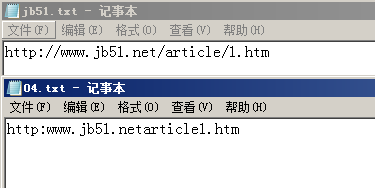Python实现将一个正整数分解质因数的方法分析
本文实例讲述了Python实现将一个正整数分解质因数的方法。分享给大家供大家参考,具体如下:
遇到一个python编程联系题目:将一个正整数分解质因数。例如:输入90,打印出90=2*3*3*5。
版本一:
开始,没动脑子就开始写了,结果如下代码
#! /usr/bin/python
# 014.py
import math
number = int(raw_input("Enter a number: "))
while number != 1:
for i in range(1, number + 1):
if (number % i) == 0 and i != 1:
number = number / i
if number == 1:
print " %d" %i
else:
print " %d*" %i,
break
结果,输入9876543210这个十位数的时候,报错:
Traceback (most recent call last):
File "./014.py", line 8, in <module>
for i in range(1, number + 1):
OverflowError: range() result has too many items
版本二:
版本一报错是因为range有了太多的项,于是想着减少range出的list的项。由于,在判断一个数n是否是质数的时候,只需从2到n的平方根就行了,所以有了版本二,代码如下:
#! /usr/bin/python
# 014_1.py
import math
number = int(raw_input("Enter a number: "))
list = []
def getChildren(num):
print '*'*30
isZhishu = True
for i in range(2, int(math.sqrt(1 + num)) + 1): #多加个1
if num % i == 0 and i != num :
list.append(i)
isZhishu = False
getChildren(num / i)
break
if isZhishu:
list.append(num)
getChildren(number)
print list
这样,数字可以增大很多而不至于报错。但是 ,也是很有限度的,当输入大数如 123124324324134334 时,会导致内存不足,杀死进程
Traceback (most recent call last):
File "./014_1.py", line 20, in <module >
getChildren(number)
File "./014_1.py", line 11, in getChildren
for i in range(2, int(math.sqrt(1 + num)) + 1):
MemoryError
为了追求能对更大的数进行操作,猜想原因可能是递归调用时每次都需要建立一个很大的由range()建立的list,于是想避免range的使用,于是有了版本三:
版本三:
代码
#! /usr/bin/python
# 014_1.py
import math
number = int(raw_input("Enter a number: "))
list = []
def getChildren(num):
print '*'*30
isZhishu = True
i = 2
square = int(math.sqrt(num)) + 1
while i <= square:
if num % i == 0:
list.append(i)
isZhishu = False
getChildren(num / i)
i += 1
break
i += 1
if isZhishu:
list.append(num)
getChildren(number)
print list
同样对123124324324134334 进行操作,速度很快,得到如下结果
Enter a number: 123124324324134334
******************************
******************************
******************************
******************************
******************************
[2, 293, 313, 362107, 1853809L]
PS:这里再为大家推荐几款计算工具供大家进一步参考借鉴:
在线分解质因数计算器工具:
http://tools.jb51.net/jisuanqi/factor_calc
在线一元函数(方程)求解计算工具:
http://tools.jb51.net/jisuanqi/equ_jisuanqi
科学计算器在线使用_高级计算器在线计算:
http://tools.jb51.net/jisuanqi/jsqkexue
在线计算器_标准计算器:
http://tools.jb51.net/jisuanqi/jsq
更多关于Python相关内容感兴趣的读者可查看本站专题:《Python数学运算技巧总结》、《Python数据结构与算法教程》、《Python函数使用技巧总结》、《Python字符串操作技巧汇总》、《Python入门与进阶经典教程》及《Python文件与目录操作技巧汇总》
希望本文所述对大家Python程序设计有所帮助。

